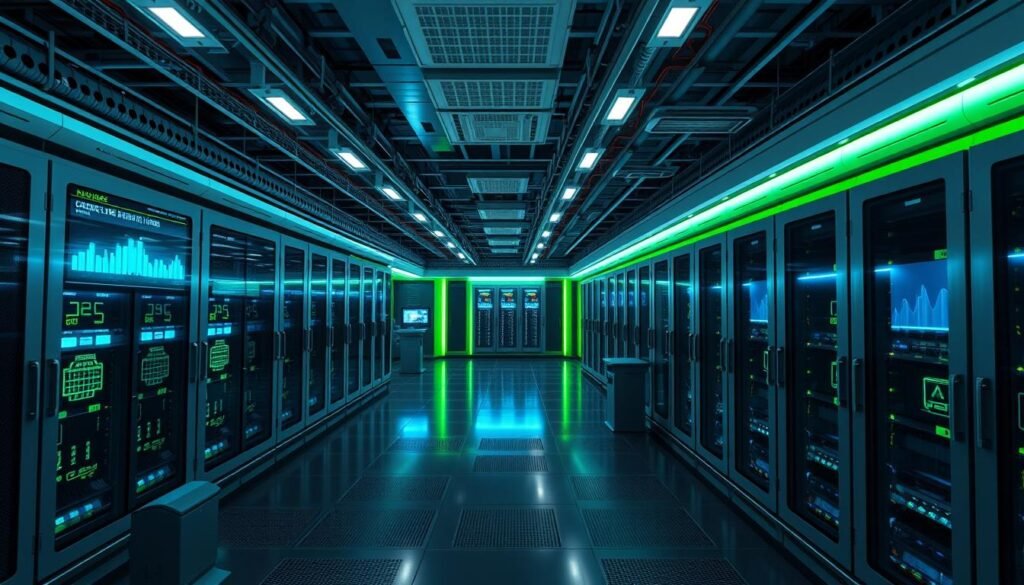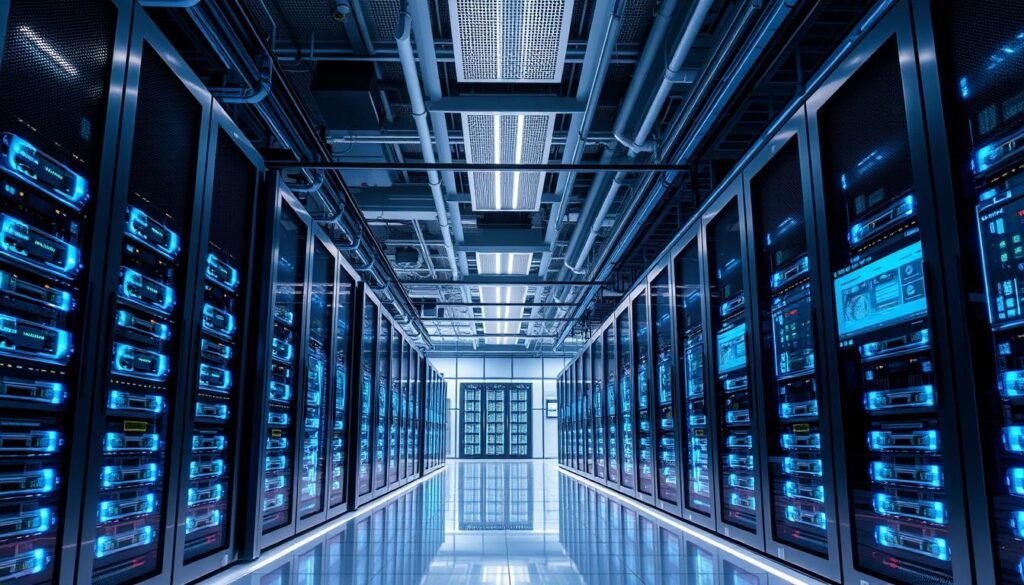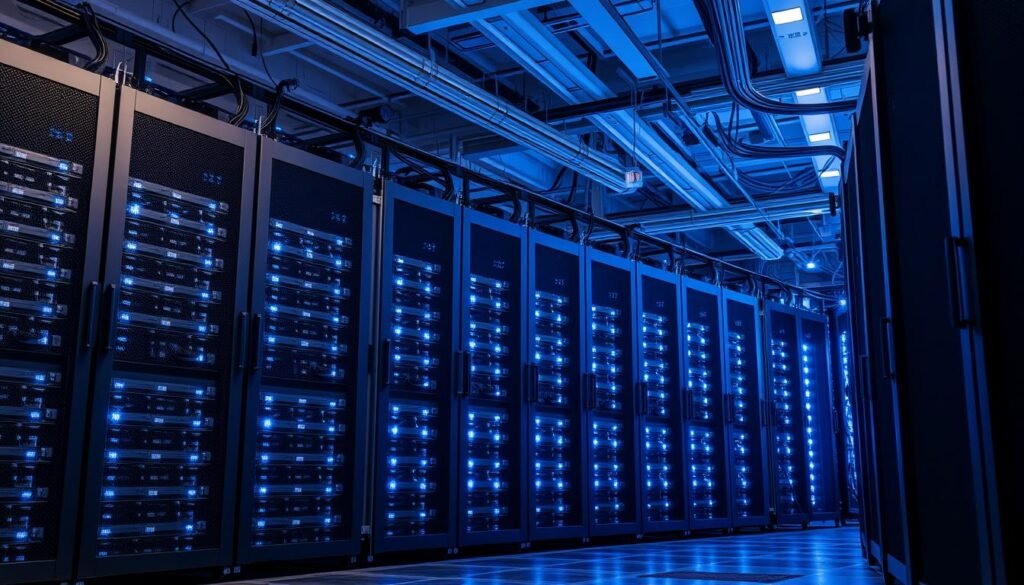In today’s fast world, your data center’s efficiency and uptime are key to success. But what makes top data centers stand out? It’s a deep, strategic approach to management.
Want to unlock your data center’s full power and grow your business? This guide will show you how to boost your data center’s performance, efficiency, and reliability.
Ready to learn the secrets of top data centers and get ahead in your field? Let’s explore how to elevate your data center’s performance and reliability.
Key Takeaways
- Optimize your data center’s physical layout and space to enhance efficiency and scalability.
- Implement robust redundancy planning and disaster recovery strategies to ensure seamless uptime.
- Leverage advanced cooling solutions and power management techniques to boost energy efficiency.
- Strengthen your data center’s security posture with complete physical and cybersecurity measures.
- Utilize performance monitoring and analytics tools to identify optimization opportunities.
- Adopt sustainable practices and green computing initiatives to reduce your environmental impact.
- Future-proof your data center infrastructure to stay ahead of evolving technology and industry trends.
Understanding Modern Data Center Architecture and Design Principles
Designing a data center is a big challenge today. It must handle growing demands in data center management, server racks, and high-density computing. Architects need to focus on three main areas: physical layout, scalability, and redundancy.
Physical Layout and Space Optimization
Using space wisely is key in data center design. Server racks, aisle layouts, and cooling systems must be well-planned. This maximizes floor space and boosts efficiency.
Modular designs make it easy to expand in the future. This ensures the data center grows with the organization.
Scalability Considerations in Design
Future growth is a big part of modern data center design. Scalable power, cooling, and networks handle more demands without stopping work. Modular designs add flexibility to meet changing needs.
Redundancy Planning and Implementation
Keeping data centers running smoothly is vital. Redundant systems like backup power and cooling units prevent downtime. They ensure the data center stays up and running, even with failures.
By following these design principles, data centers become efficient, scalable, and reliable. They’re ready to support the growing needs of data-driven businesses.
Data center, server, cloud, networking, storage, infrastructure, colocation
Building a strong data center needs a good grasp of its main parts. From cloud computing to physical network infrastructure and colocation facilities, each part is key for top performance and reliability.
At the center of any data center are the servers. These machines are the IT backbone, handling tasks from web hosting to complex data processing. Choosing the right server setup and management is key for better performance and growth.
The growth of cloud computing has changed how companies manage their IT. Cloud services offer flexibility, scalability, and cost savings. They’re becoming a top choice for businesses of all sizes. Adding cloud solutions to your data center can greatly improve efficiency.
Having reliable and fast connections is also vital for a good data center. Network infrastructure, like switches and routers, must be well-planned to meet today’s data needs.
For companies wanting to use their IT resources better without the hassle of a full data center, colocation facilities are a great option. These data centers provide secure, scalable, and energy-efficient spaces. They let businesses focus on their main tasks while experts handle the IT.
| Component | Key Considerations | Benefits |
|---|---|---|
| Servers | Performance specifications – Scalability Energy efficiency |
Reliable computing power Customizable configurations Reduced operational costs |
| Cloud Computing | – Scalability – Cost-effectiveness – Flexibility |
Reduced capital expenditure Rapid deployment of resources Improved disaster recovery |
| Network Infrastructure | Bandwidth capacity – Reliability – Security |
Efficient data transfer Uninterrupted connectivity Enhanced data protection |
| Colocation Facilities | Physical security – Redundancy Energy efficiency |
Dedicated expertise Scalable resources Cost savings |
Understanding the roles and connections of these key data center parts helps organizations build a strong IT setup. This setup meets their growing needs while improving performance, reliability, and cost-effectiveness.
Essential Components of High-Performance Computing Infrastructure
To get top performance in your data center, you need a smart plan for your setup. Focus on the main parts that make your high-performance computing (HPC) work well. We’ll look at the key things to think about for better efficiency and productivity.
Server Configuration and Management
Server virtualization is key in today’s data centers. It brings flexibility and growth. With virtualization, you can use your servers better, handle changing workloads, and boost performance. Also, good server management means your virtual setup runs smoothly, stays safe, and gets the care it needs.
Storage Systems Integration
It’s important to link storage area networks (SANs) and enterprise storage well in HPC setups. Using fast storage systems helps with big data tasks. This gives you the speed and quick access needed for important work. Matching your storage with your computing needs lets your HPC system reach its best.
Network Architecture Implementation
A strong network is the heart of any HPC setup. Using new network tech, like fast connections and software-defined networking, makes data moving faster and smoother. Designing your network well and using the latest tech can really help your HPC.
| Component | Importance | Key Considerations |
|---|---|---|
| Server Virtualization | Enhances flexibility and scalability | Optimize server resource utilization, streamline management, and ensure security |
| Storage Area Networks | Provides high-performance storage solutions | Integrate enterprise-grade storage systems to handle data-intensive workloads |
| Network Architecture | Enables fast data transfer and low latency | Implement advanced networking technologies and design efficient network topologies |
By looking closely at and improving these key parts, you can create a strong and fast computing setup. This setup will meet your organization’s most important needs.
Optimizing Power Distribution and Management
Keeping a steady power supply is key for any data center’s smooth running. In critical situations, having extra power systems is vital to avoid sudden shutdowns. A smart plan for power use and management can greatly boost your data center’s performance and reliability.
Creating a strong redundancy plan is a big step in power optimization. This means setting up several power sources and paths to ensure no single failure can stop everything. With redundant power systems, your critical apps stay up and running, even when power goes out.
- Find out which systems are most important and add backup power like generators or batteries. This way, your data center keeps running even when the main power fails.
- Place power distribution units (PDUs) and automatic transfer switches (ATS) wisely. They help balance loads and switch power sources smoothly.
- Make sure to test and keep your backup power systems in top shape. This ensures they’re ready to kick in when needed.
Data centers can also improve power management with advanced monitoring tools. These tools give real-time power use insights. This helps facility managers spot and fix inefficiencies, balance loads better, and make smarter energy-saving choices.
| Power Management Strategies | Benefits |
|---|---|
| Dynamic power capping | Prevents overloading of power distribution systems and ensures reliable operation |
| Intelligent power scaling | Adjusts power consumption based on workload, reducing energy waste |
| Power usage effectiveness (PUE) monitoring | Tracks and optimizes the ratio of total facility power to IT equipment power, improving overall efficiency |
With a solid power optimization plan, data center managers can keep their mission-critical applications running smoothly. This reduces downtime risks and boosts the value of their investments.
“Reliable power distribution is the backbone of any high-performance data center. By embracing redundancy and advanced power management techniques, you can unlock new levels of operational efficiency and resilience.”
Advanced Cooling Solutions for Maximum Efficiency
In today’s fast world, keeping data centers cool is key for smooth operations and top performance. Data center managers use advanced cooling technology and airflow strategies to boost efficiency and cut energy use.
Precision Cooling Technologies
Old cooling systems are a thing of the past. Now, data centers use precise cooling that fits each server’s needs. This includes high-density units and direct-to-chip cooling, making cooling more efficient by avoiding hot spots.
Airflow Management Strategies
- Hot and cold aisle containment systems help manage airflow, keeping hot and cold air separate.
- Variable-speed fans and smart HVAC controls adjust cooling as needed, based on demand.
- Placing racks and servers wisely ensures air flows well and heat is dissipated efficiently.
Temperature Monitoring Systems
Keeping an eye on temperature is vital for data center cooling. Advanced sensors and analytics give real-time thermal data. This lets managers spot and fix hot spots, improve airflow, and fine-tune cooling for best results.
By using these tools, companies can lower their data center cooling costs and reduce their enterprise IT environmental impact.
Implementing Effective Infrastructure Management Systems
In the fast-paced world of data centers, a strong infrastructure management system is key. It ensures top performance and keeps downtime low. This part explores strategies and tools for better infrastructure management and data center operations.
Good infrastructure management systems cover monitoring, upkeep, and optimization. The right tools and methods give you deep insights into your data center. They help spot problems early and fix them before they get worse.
Monitoring and Reporting
Real-time monitoring is the base of efficient infrastructure management. These tools track server use, network traffic, power use, and more. By watching these key areas, you can spot and fix problems fast.
Predictive Maintenance
Predictive maintenance uses data to foresee equipment failures and plan ahead. It helps cut downtime, extend equipment life, and use resources better.
Automation and Orchestration
Automation and orchestration make managing infrastructure smoother. They cut down on mistakes and keep tasks consistent. From updates to setting up virtual machines, these tools boost data center efficiency.
“Effective infrastructure management is not just about troubleshooting, but about proactively optimizing your data center to achieve maximum performance and reliability.”
With a solid infrastructure management system, you get many benefits. You’ll see better uptime, use resources better, and meet your business goals. Use data to make smart choices and elevate your data center’s performance.

Security Protocols and Access Control Measures
Keeping your data center safe is key in today’s digital world. You need strong network security and data backup plans. These are vital for keeping your operations running smoothly.
Physical Security Implementation
Physical security is your first defense against unauthorized access. Use advanced access control systems like biometric scanners and RFID badges. Also, have secure entry points and strict visitor rules.
Regular patrols, cameras, and strict visitor rules add to your data center’s safety.
Cybersecurity Framework
A solid cybersecurity framework is just as important as physical security. It includes firewalls, intrusion detection, and anti-malware. Keeping your security up to date is essential to fight off new threats.
Access Management Solutions
- Use role-based access controls to limit who can access sensitive areas.
- Multi-factor authentication, like biometric scans, adds an extra layer of security.
- Always check and update access rights to match job roles and least privileges.
With these security steps, you can protect your data center from many threats. This ensures your systems and data stay safe and available.
“Cybersecurity is not an option, it’s a necessity in today’s data-driven world.”
Disaster Recovery and Business Continuity Planning
In a fast-paced data center environment, maintaining seamless business operations during unexpected events is essential. Effective disaster recovery plans protect critical data and ensure business continuity, even in challenging circumstances.
Data Backup as a Foundation
The backbone of any disaster recovery plan is a robust data backup strategy. Cloud-based backup and storage solutions provide secure backup data centers that enable swift recovery after a disaster. By combining on-site and off-site storage, organizations can prevent data loss and accelerate system restoration.
Building Redundancy for Resilience
A successful plan extends beyond data backups—it also requires strategic redundancy. Incorporating backup power sources, additional network links, and extra servers helps maintain continuous operations. Planning for failovers and redundancy reduces the impact of equipment failures, cyber-attacks, and natural disasters.
Leveraging Cloud Solutions for Agility
Cloud-based networking solutions strengthen disaster recovery efforts by offering scalable, on-demand resources that help data centers recover quickly. The extensive reach and resilient infrastructure of cloud providers provide coverage and support beyond a single physical location, minimizing downtime and safeguarding data.
Ongoing Testing and Improvement
Disaster recovery and business continuity planning require continuous attention. Regular drills, testing, and updates help identify vulnerabilities and strengthen resilience. Frequent risk assessments and simulations allow for plan refinement, improving readiness for future challenges.
Building Trust Through Preparedness
Prioritizing disaster recovery and business continuity not only protects your data and operations but also fosters trust with customers, partners, and stakeholders. A strong disaster recovery strategy is crucial to staying resilient and successful, even in the face of adversity.
| Backup Solution | Redundancy Planning | Cloud-based Recovery |
|---|---|---|
|
|
|
“Effective disaster recovery planning is not just about backing up data, but about ensuring the resilience of your entire data center infrastructure.”
Taking a complete approach to disaster recovery and business continuity is vital for your data center’s success. By using the latest tech, planning for redundancy, and using cloud solutions, you make your business stronger. This sets the stage for growth and success in the future.
Performance Monitoring and Analytics Tools
In the fast-paced world of data center infrastructure management and enterprise IT, it’s key to have top-notch performance monitoring and analytics tools. These tools help keep your data center running smoothly and efficiently. They give you the power to see what’s happening in real-time, spot problems before they start, and fix them quickly.
Real-time Monitoring Solutions
Real-time monitoring tools give you a detailed look at how your data center is doing. They track important things like how busy servers are, network traffic, power use, and temperature. With these tools, you can find and fix problems fast, stopping big issues before they start.
Predictive Analytics Implementation
Adding predictive analytics to your data center work brings big benefits. These tools look at past data to guess what might happen next. They help you plan better, use resources wisely, and avoid big problems.
Performance Optimization Strategies
- Use real-time data to make your servers, networks, and storage better.
- Use predictive analytics to know when you need more resources and get them ready.
- Use automation and machine learning to make managing your data center easier and less prone to mistakes.
By using the best performance monitoring and analytics tools, you can make your data center infrastructure management and enterprise IT better. This keeps your organization flexible, strong, and always ready for what’s next.
Cost-Effective Resource Allocation Strategies
In the world of data center management, finding a balance is key. You need to meet performance needs while saving money. A smart approach to using resources can lead to big savings without losing efficiency.
Optimizing hardware is a good start. Techniques like virtualization and containerization help use your current setup better. This means you don’t need as many servers, saving you money on both the upfront cost and ongoing expenses.
Cloud computing is also a big help in saving money. It offers scalability and flexible pricing. This lets you adjust to your business’s changing needs without breaking the bank.
For data storage, a tiered approach is smart. It matches storage types with how much you need to spend and how fast you need it. This way, important data gets the best storage, while less important data gets cheaper options.
| Storage Solutions | Cloud Computing |
|---|---|
| Tiered storage approach to align performance and cost | On-demand scalability and pay-as-you-go pricing models |
| Leverage high-performance storage for critical data | Tap into the economies of scale offered by cloud providers |
| Utilize cost-effective storage options for less critical data | Maintain flexibility to adapt to changing business needs |
By using these strategies, you can make your data center more efficient and save money. This opens up new chances for growth and innovation.
Environmental Sustainability and Green Computing Practices
In today’s digital world, data centers’ environmental impact is a big worry. As we need more computing power and data storage, it’s key for companies to use green practices. These practices help cut down on carbon emissions while keeping energy use and performance high.
Energy Efficiency Measures
Energy-efficient technology and strategies are at the heart of green computing. This means using servers that use less power, virtualizing hardware, and using solar or wind power for data centers. By cutting down on power use and waste, companies can lessen their environmental harm.
Sustainable Technology Implementation
Choosing sustainable tech is also vital in green computing. This includes using cool, eco-friendly cooling systems like liquid or free cooling. Also, picking energy-saving storage and networking gear makes data centers more sustainable.
Carbon Footprint Reduction Strategies
- Using smart server and infrastructure management to cut energy use.
- Supporting renewable energy and looking into on-site energy like solar panels.
- Designing data centers for better airflow to need less cooling.
- Encouraging eco-friendly materials and recycling for IT waste.
By taking on these green computing steps, companies can lessen their environmental harm. They also make their data centers more efficient and sustainable. This helps create a cleaner, greener future for all.
Future-Proofing Your Data Center Infrastructure
Technology is changing fast, and your data center needs to keep up. By using future-proofing strategies, you can protect your investments. This keeps you ahead in the digital world.
Scalability is key for your server infrastructure. A scalable network architecture lets you grow easily. This means more data, users, or tasks without trouble. Modular systems give you the flexibility to meet changing needs.
It’s also smart to adopt new technologies. Keep up with cloud, edge computing, and software-defined networking. These advancements can make your infrastructure better and more efficient.
- Make your server infrastructure scalable and modular for future growth.
- Keep an eye on new network architecture trends like cloud and edge computing.
- Check your data center’s performance often to find ways to improve.
- Invest in a strong infrastructure management system for better control.
| Feature | Benefit |
|---|---|
| Scalable server infrastructure | Easily accommodate growth and changing business demands |
| Adaptable network architecture | Integrate emerging technologies to boost performance and efficiency |
| Comprehensive infrastructure management | Maintain visibility and control over your entire IT ecosystem |
By using these strategies, your data center will stay strong and efficient. It will be ready for the future’s challenges and chances.
“The future is already here – it’s just not evenly distributed.” – William Gibson

Conclusion
Optimizing data center efficiency and uptime is complex. It needs a complete approach. This includes understanding modern data center design and using advanced cooling solutions.
It’s about finding the right balance between performance, efficiency, security, and sustainability. By following the strategies in this guide, you can make your data center better. It will be more resilient and ready for the future.
Using the latest technologies in power, cooling, and monitoring can improve efficiency and uptime. This will help your organization stay competitive and strong.
The path to data center excellence is ongoing. It demands a commitment to innovation and improvement. Stay updated with industry trends to make your data center a key asset for your organization’s growth.
Focusing on data center efficiency, uptime, and performance optimization lays the foundation for unmatched operational excellence. By enhancing these critical areas, organizations can ensure seamless service delivery, reduce downtime, and position themselves for future growth and resilience.



